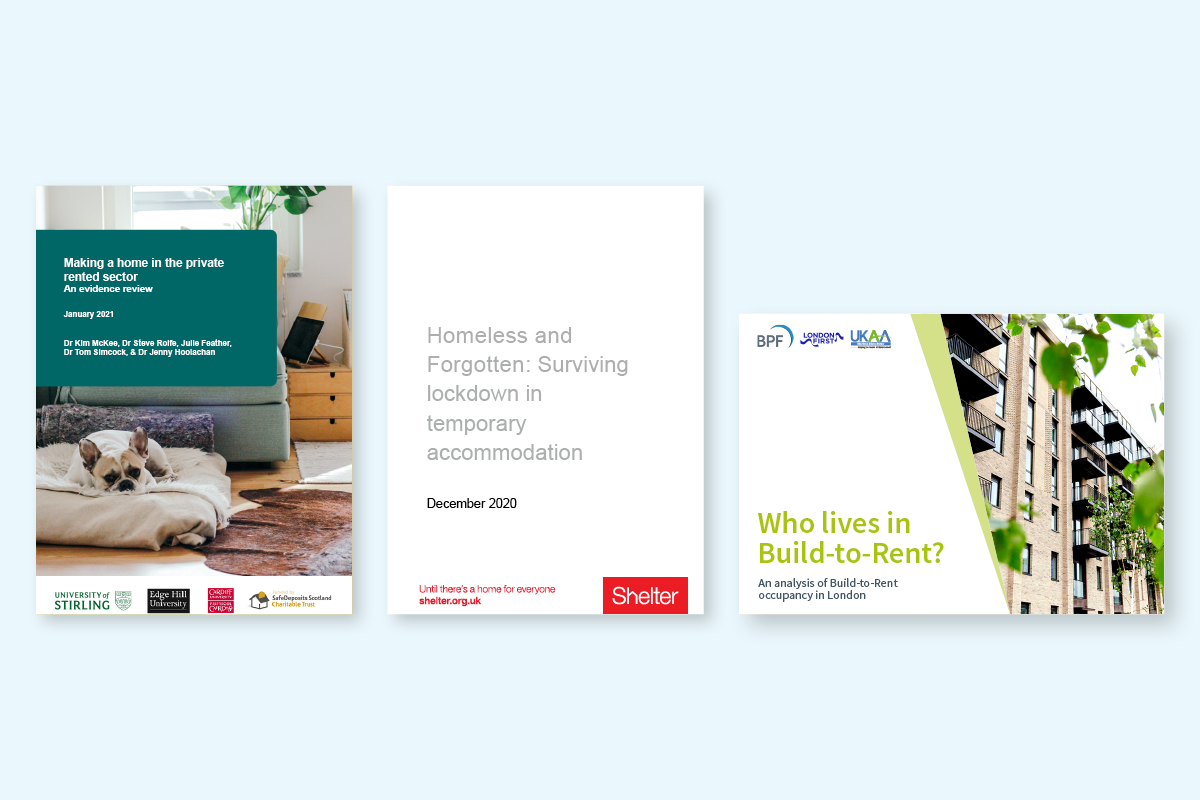You are viewing 1 of your 1 free articles
 Brian Robson
Brian RobsonBrian Robson is executive director (policy and public affairs) at the Northern Housing Consortium
The Thinkhouse Review: what research tells us about the impact of the pandemic on residents based on tenure
People should reflect on the gulf in experience between households living in high-quality developments and people who have spent lockdown in temporary accommodation, writes Brian Robson in this month’s Thinkhouse Review
With around one in five households now making a home in the private rented sector, three new reports selected for this month’s Thinkhouse Review of the latest research offer insights into the experiences of different households over the past year and present options for change.
A team led by Dr Kim McKee, a senior lecturer of housing studies at the University of Stirling, has reviewed the evidence in Making a House a Home in the Private Rented Sector. Their report acknowledges that what we mean by home is – naturally – subjective, but finds that existing evidence suggests three key elements can turn a place into a home. These elements are:
- A comfortable space that is a haven from stress
- A place to socialise and a source of social status
- Somewhere that offers autonomy and independence
Dr McKee and her team focus on ways in which landlords and letting agents can help their tenants create a home. They find that the way landlords and their agents manage property condition, the way they select their tenants and the way they interact with tenants can all have an important impact on tenants’ ability to make a home.
The report’s focus on practice is a useful reminder that change doesn’t just come from policy and, of course, that sustaining successful tenancies is a win-win for the tenant and landlord.
There’s another look at current practice in Who Lives in Build to Rent?, a new analysis of the growing number of homes in London that have been built especially for private renting. This publication comes from the British Property Federation, London First and the UK Apartment Association, and is an interesting look at a growing part of the private rented sector that we (so far) know too little about.
While the publishers have a particular perspective, the analysis sets out examples of build-to-rent schemes that offer many of the features that Dr McKee’s research identifies as the elements that turn a place into a home. Residents quoted said they felt “comfortable” and “lucky” to be living in build-to-rent developments during lockdown.
While the resident lounges and gyms provided on site may not have had heavy use, the report notes that property managers had tried to provide social connection through online forums and socially distanced exercise classes. Social status might be derived from having a concierge ‘who knows your name’ and autonomy and independence being on offer, with “family-friendly long-term tenancies” and “predictable rents”.
Such marketing claims are difficult to verify, but it’s clear this is being pitched as a high-quality product that challenges perceptions of private renting. What I am less convinced about is the claims in the report that this tenure is “providing housing for all” – the analysis shows that 94% of residents are in work and the majority are earning more than £32,000.
That’s a far cry from the families featured in the third report I want to highlight. Both from charity Shelter, senior researcher Jenny Pennington and research officer Hannah Rich have conducted an analysis of those who spent lockdown in temporary accommodation.
This included speaking to 20 households who shared their lived experience of being in temporary accommodation during a pandemic. Shelter’s findings are stark. More than 250,000 people spent the first stages of the pandemic in temporary accommodation in England. While not all of this accommodation would be classed as private rented, the vast majority is owned, or owned and managed, by private providers.
The three elements of home were in scarce supply for these families. Far from being a comfortable space that offers a haven from stress, residents reflected on their “intense fear” and shared how life in temporary accommodation during the coronavirus pandemic had affected their mental well-being.
Social status was in short supply. Residents said they had felt “reclusive” and that their life could only really begin once they had “a proper home”. Autonomy and independence weren’t on offer. People told the researchers about feeling that their lives were on hold while they wondered whether they would move or not: “There’s no deadline, there’s no time limits. You don’t know how long you’re going to be there.”
Shelter’s report offers a range of sensible policy solutions: more social housing, a realistic Local Housing Allowance without an arbitrary household benefit cap, and bringing temporary accommodation within the purview of the Regulator of Social Housing.
Reading all three reports, it would be difficult not to reflect on the gulf in experience between households living in high-quality build-to-rent developments and people who have spent lockdown in temporary accommodation.
It made me reflect that if we could combine security of tenure with Shelter’s recommendations on a Local Housing Allowance fit for the future and the innovation shown by private capital in the build-to-rent report, we might just be able to create a private rented sector that enables people living on a low income to enjoy the elements that make a place a home. That really would be a win-win.
Brian Robson is executive director of policy and public affairs at the Northern Housing Consortium
What is Thinkhouse?
Thinkhouse is a website set up to be repository of housing research. Its editorial panel critiques and collates the best of the most recent housing research. Click here to find out more.
Sign up for our daily newsletter
Already have an account? Click here to manage your newsletters













